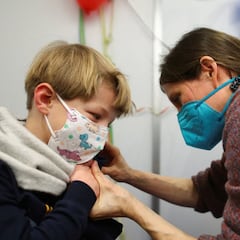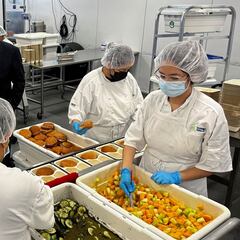Coronavirus: how many cases are there in New York?
Covid-19 cases surged in the city, and around the United States, over the weekend and hopes for a more normal holiday season appear to have been dashed.

There was an expectation just a few weeks ago that a relatively normal Christmas was in store for New Yorkers, with excitement building about a return to Times Square for the famous New Year celebration. But as coronavirus cases surged in the city, and around the United States over the weekend, hopes for a more normal holiday season have been dashed, and the country's testing infrastructure stretched just days before many families gather.
New York: Omicron taking hold
In New York, new covid-19 cases rose 60% in the week that ended on Sunday as the Omicron variant spreads rapidly around the US northeast. New York has set records for the most new cases reported in a single day since the pandemic started for three consecutive days.
The rise in cases has set off alarm bells for public health officials, who see Omicron fast becoming dominant in the United States and fear an explosion of infections after holiday gatherings. With the new variant in circulation, the number of covid-19 cases is now doubling in one and a half to three days in areas with community transmission, the World Health Organization said on Saturday.
More US news:
- Christmas Eve: do you get the day off?
- Does Omicron evade the vaccine?
- CDC says Omicron 'likely' spreads more quickly than previous strains
- Antiviral covid-19 pill could be approved this month
- Dark clouds for stimulus checks in 2022
The variant has dampened holiday spirits among the vaccinated with rising breakthrough infections reported even among those who received booster shots.
Cautious Omicron optimism
Omicron appears to be causing much milder symptoms in vaccinated populations, and health experts remain optimistic this wave might not cause the same spikes in hospitalizations and deaths as previous surges.
New York City Health Commissioner Dr. Dave Chokshi on Monday said that while new covid-19 cases have 'increased sharply,' hospitalizations have not jumped at the same rate. He credited vaccinations and booster shots, which help prevent severe illness, and urged that more were needed to build a 'sea wall' against the variant.
Nationally, cases rose 9% in the past week but are up 57% since the start of December, according to a Reuters tally.
Hospitalized covid-19 patients have increased 26% this month, with hospitals in some areas already strained by the Delta variant.
While cases climb in the Northeast, Midwest hospitals are still dealing with a surge in patients from a Delta wave this fall. Michigan, Indiana and Ohio have the nation's most hospitalized covid patients per 100,000 residents, a Reuters tally found.
The power of vaccines: COVID-19 cases (red) and deaths (grey) in New Jersey, via @nytimes. pic.twitter.com/gmGY3FyFl2
— Rob Tornoe (@RobTornoe) December 20, 2021
On Monday, Maryland Governor Larry Hogan announced he tested positive for covid-19. US Senators Cory Booker and Elizabeth Warren said the same on Sunday. All three said they had been vaccinated and boosted.
Coronavirus testing faces supply issues
Lines for covid-19 tests wrapped around the block in New York, Washington D.C., and other US cities over the weekend as people clamored to find out if they were infected before celebrating holidays with family.
In New York City, the daily test rate reached an average of 130,000 per day, Mayor Bill de Blasio told reporters on Monday, more than double three weeks ago. But demand for tests continues to exceed capacity.
'We're seeing a supply problem that needs to be addressed,' de Blasio said, noting that the city was working with the White House and private sector to help increase testing availability.
The city's covid-19 vaccine mandate for childcare workers, affecting some 102,000 people, was due to go into effect on Monday.
Governor Kathy Hochul said on Monday that she was ramping up the state’s testing program, with 1 million kits arriving this week and the same amount in each of the next two weeks.
“More and more people are going to be testing positive from this,' she said. For those who do, she advised: 'Just stay home, do not go out. Don't go to work. Don't go see your family.'
Omicron's arrival is a headwind for an economic revival in New York already lagging the rest of the country, especially where employment is concerned.
The city will be distributing half a million rapid at home tests and 1 million K95 masks, says @BilldeBlasio
— Erin Durkin (@erinmdurkin) December 16, 2021
The pandemic delivered an even larger body blow to the city than the country as a whole because of the outsized role played by tourism, leisure and hospitality, which suffered the worst under lockdowns and travel restrictions. New York's jobless rate topped out at 20% in the spring of 2020 - more than 5 percentage points above the US average.
The rollout of vaccines early in 2021 helped spur some improvement as restaurants were allowed to resume indoor dining with fewer limits and some businesses including a number of Wall Street firms began reopening offices, bringing an uptick of commuters into dormant business districts. The more recent resumption of international travel brought foreign tourists to New York for the first time in nearly two years.
Still, the city's job market continues to struggle. The unemployment rate at 9% is more than twice the national rate, and the work force - the pool of potential labor - has fallen every month since April.
While city life has not shut down as it did in the early days of the pandemic, some businesses have closed due to positive tests among staff or an abundance of caution.
Related stories
Henrietta Hudson, an iconic LGBTQ hangout in New York City, announced it will close for an 'extended holiday break.'
'We hope to offer you a New Year's Eve experience ... but will have to wait and see,' the bar said in an Instagram post on Sunday.

